|
Looking back
Sumer - birthplace of civilization
****
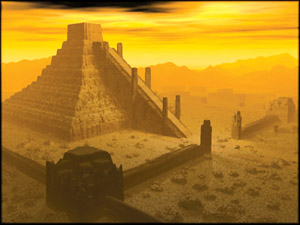
Fact file
* It is estimated that by 2500 BC, the population of Sumer exceeded
|
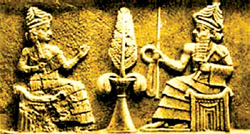
A frieze made art of beaten gold.
|
half a million.
* Even though the largest water works project, the Hanging Gardens of
Babylon came after Sumer's time, it is believed that the Babylonians may
have used Sumerian technology to create this.
* The invention of the wheel in Sumer not only allowed a great
increase in the trading of food surpluses, but also greater military
mobility.
* The idea for the invention of the wheel for transportation may have
originated from the potter's wheel used to
|
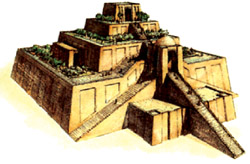
A drawing of a ziggurat
|
mould lumps of clay into jars and vases.
|
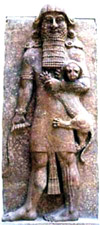
A clay statue
|
* Original writing made use of thousands of pictographs.
* Art was primarily used for religious purposes.
* Clay was the most abundant material.
* Cuneiforms were written on clay tablets on which symbols were drawn
with a blunt reed known as a stylus. The impressions left by the stylus
were wedge-shaped and so the name cuneiform.
* The ziggurat ruins of Eridu seem to be the best match of famous
Biblical descriptions of the unfinished Tower of Babel.
*****
Some of you may have already learned about the great civilizations of
the world that developed along rivers in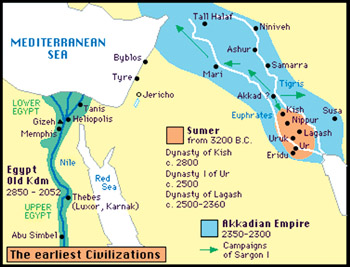 the ancient world. the ancient world.
The birth place of the first great civilization was Sumer, which was
located in southern Mesopotamia (now Iraq) between the Tigris and
Euphrates rivers. Its history could be traced from about 3500BCE until
2000 BCE, when the Babylonians rose to power.
The term Sumerian applied to all who spoke the Sumerian language.
They were a non-Semitic people who farmed the land made fertile by silt
(mud) deposited by the Tigris and Euphrates rivers. They learned not
only to survive, but also to prosper and become the world's first
settled society, together with Ancient Egypt and the Indus Valley
Civilization.
The Sumerians certainly seem to have realised the importance of
controlling floodwater in the rivers in order to carry out their
agricultural activities.
They did so many things to control the water in the arid southern
flood plane where the rainfall was less than five inches a year. They
built dams, tanks and reservoirs to develop their agriculture, which was
heavily dependent on irrigation.
What do you think they grew as crops? You will be surprised to learn
that they cultivated not only barley, chickpeas and dates, but also
garlic, onions, lettuce, leeks and mustard. They also raised cattle,
sheep, goats and pigs, caught fish and hunted animals.
They used the oxen as their prime beast of burden. Donkeys were one
of the animals they used to transport goods. But once the wheel was
invented, transportation became much easier for them.
Of course no one really knows when even the potter's wheel (the
smaller version) was invented, but there is evidence that around 6,000
years ago, the wheel was used in Mesopotamia. In fact, by about 3200BC,
simple carts had already been in existence. The Sumer civilization which
lasted about 3,000 years, grew and developed into the great civilization
we know of today, under many dynasties in different time periods.
The Jemdest Nasr Period (3200 to 2900 BC) represents the transition
from prehistoric to history and literate civilization (urban
revolution).The Sumerians who were so named by their successors, the
Semitic Akkadians, called themselves sag-giga, which literally meant the
'black-headed people'.
As the Sumerians grew in prosperity and their population increased,
the living density (mass per unit of volume) in the area too grew. It is
recorded that at least 2,000 people existed in 10 hectares of one of the
earliest cities known as Eridu. The number of people in larger cities
were about 50,000. It was these larger cities that later developed into
city states, which were independent areas with their own deities.
It's difficult to speak of a Sumerian religion as such, since
practices and beliefs varied widely. Each city had its own
interpretation of theology and mythology. However, the Sumerians
worshipped a God named An as their primary god and many other gods. The
word 'an' in Sumerian means 'sky'. Religion was the central organising
principle of the city states.
These cities were ruled by a priest (en), king (lugal) or governor (ensil),
and the areas were defined by canals and boundary stones.
Many wars were waged between these different cities. The kings often
succeeded in taking control of many cities in the area, but none ever
ruled over all of Sumer. The royal families were very rich and wore fine
clothes.
When we refer to royalty, you may wonder if the Sumerians built
castles and fortresses for their kings like other ancient people did.
Well, they did have very impressive structures, such as the ziggurats,
which were large layered platforms that supported temples.
The king of that city who was also the high priest, carried out
religious ceremonies and sacrifices in the temples built at these
places. One of the problems the early Sumerians faced in the
construction of dwelling places was the lack of raw materials.
Their structures were made of mudbricks and not with mortar or
cement. So, they were destroyed easily and had to be built many times
over. The new structures were most often built over the old ones.
The Sumerians also used reed to build their houses.
The Sumerians traded with people in the Persian Gulf and bought home
ivory and many luxury items. When we look back at the great Sumer
civilization, we realise how they have contributed to the world. Many
things we enjoy today are because of what they discovered through their
blood, sweat and tears...
****
What the Sumerians discovered and introduced to the world
|
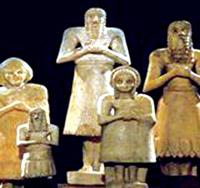
Sumerians sculpted statues using many raw materials
|
|
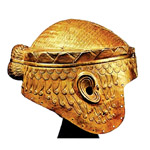
A gold helmet
|
* It is believed that the Sumerians were probably the first to invent
writing about 5,000 years ago. Originally they used pictographs
(pictures) to get their message across, but later altered them to
wedge-shaped symbols.
They first wrote in columns from right to left. Then as they
developed, the Sumerians began to write in rows going from left to
right. This later developed to what we now call cuneiform
(wedged-shaped) writing. The development of writing was closely
connected to the growth of Sumerian civilization. Writing allowed for
the permanent recording of laws, stories and records.
* Developed the oldest known law system as well as the city state.
* Developed the study of mathematics, astronomy and other sciences
|

Cuneiforms were written on clay tablets
|
* They found many ways of understanding time and even had an accurate
calendar which was vital for their agricultural activities.
* The Sumerians were the first to use the alloy, bronze and develop
instruments.
* Created jewellery using gold and silver.
* Sculpted statues out of stone, marble, wood, beaten gold and other
metals.
* Clay pottery and clay cylinder seals to mark property or documents
which were highly sophisticated were
|
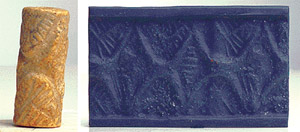
Clay cylinder seals
|
made.
|
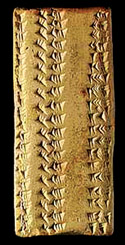
Pictographs such as these were used in early writing
|
* We could say that the world's first schools were in Sumer, because
in order to teach writing, formal education was necessary. However, only
boys were taught writing and that too was carried out in schools
attached to the temples. Harsh methods were used to encourage learning.
* Societies of Mesopotamia based their mathematical systems upon the
number 60 (compared to the number 10 we use). We still use the number 60
in some instances such as, 60 minutes in an hour, 60 seconds in a minute
and 360 degrees in a circle.
* The Sumerians used sundials. They divided the day into 12 parts and
each part was about two hours long.
They measured the length of shadow to determine how much time
had passed.
* By about 3,000 BC, the Sumerians were drawing images of tokens on
clay tablets to keep records of their goods and supplies. We could call
them the first book keeping system. Different types of goods were marked
by different symbols and multiple quantities were indicated by
repetitions. |
